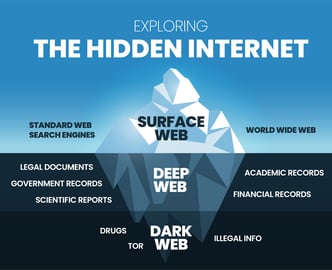A breeding ground for illegal activities, data breaches, and the sale of stolen personal information? Welcome to the dark web!
Protecting our digital identity has become paramount as our personal information is increasingly digitized and vulnerable to cyber threats.
As Anthony mentioned in his video on the Dark Web, the internet we use represents less than 10% of what’s really out there and is readily accessible to average users. The larger web is comprised of 3 main layers:
Surface Web: As the part of the internet that most people use, it can be accessed via search engines like Google and contains content like web pages, Ecommerce, videos, cat memes, etc. The surface web does contain malicious websites and users are advised to avoid clicking on links from unknown sources and to use strong unique passwords on every account they control.
Deep Web: This part of the internet is not indexed by search engines and consists of private databases, government systems, scientific research, and content that cannot be accessed by general users. Access to the deep web requires specialized software and a VPN (virtual private network).
Dark Web: The dark web is intentionally hidden and can only be accessed using specialized software. The dark web is notorious for illegal activities involving weapon sales, drug trafficking, and hacked user and business data. Being a refuge for hackers and cybercriminals, the dark web is a dangerous place to access and presents substantial security and legal risks to users and devices.

Knowing that hacked data often shows up on the dark web, it’s crucial to understand how it’s monitored.
Understanding Dark Web Monitoring
Dark Web Monitoring is a process that involves scanning and monitoring hidden online platforms for signs of compromised or stolen personal information, including usernames, passwords, credit card details, social security numbers, and more.
What is Dark Web Monitoring and How Does It Work?
Dark Web Monitoring employs sophisticated tools and technologies to scan the dark web and identify stolen information using this process:
- Data Collection: Dark Web Monitoring services collect vast amounts of data from various sources, such as hacker forums, underground marketplaces, etc.
- Scanning and Analysis: Advanced algorithms and machine learning techniques are utilized to analyze the collected data, searching for patterns and indicators of compromised information.
- Alert Generation: When compromised data is detected, Dark Web Monitoring services generate alerts to notify individuals or organizations about the potential breach. These alerts often include details of the compromised information, enabling prompt action to mitigate the risks.
- Remediation and Protection: Dark Web Monitoring services may provide guidance on mitigating the impact of a breach, such as changing passwords, enabling two-factor authentication, or contacting financial institutions to protect accounts. Some services may also offer identity theft protection measures.
While the dark web presents an ongoing threat to our digital identities, Dark Web Monitoring services offer a powerful tool for remaining vigilant. By actively scanning hidden online platforms for compromised information, these services provide individuals and organizations with early breach detection, proactive protection, and the opportunity of mitigating potential financial and repetitional losses.
Join us tomorrow as we cover the Benefits of Dark Web Monitoring.
Learn more about Dark Web Monitoring options by signing up for a Free 30-Minute Technology Consultation.
